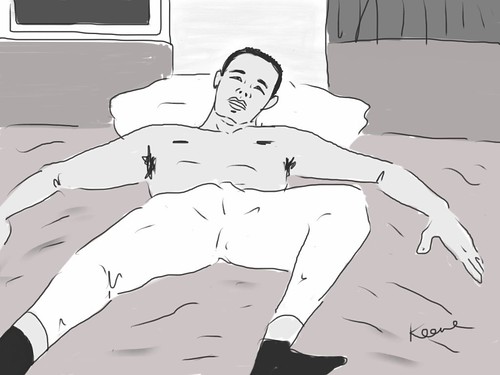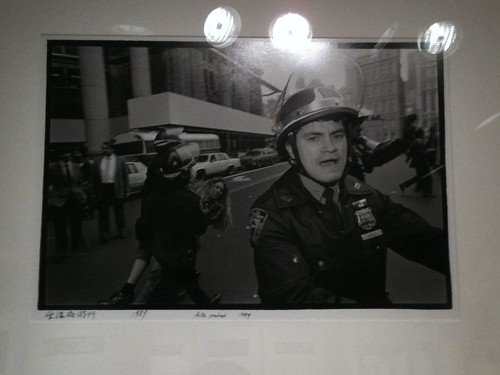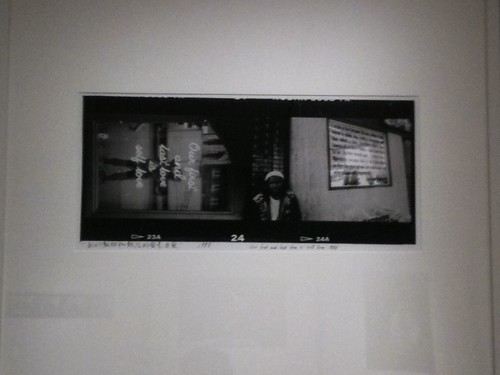While active in making art of all kinds, from site installations to interior design to books, Ai has also followed the path of his father, the poet Ai Qing, who with Ai's mother, Gao Ying, was sent by Mao Tse-Tung's government to a labor camp in 1958 for allegedly being a "rightist" in the Communist Party; in addition to speaking out against the Chinese government's suppression of human rights and cultural and political freedom, he has specifically criticized certain government actions or nonactions, such as the corruption endemic in the Sichuan local government in the years preceding the horrific 2008 Sichuan earthquake, in which thousands of children were killed because of shoddy schoolbuildings. His outspokenness has led to repeated detentions, including this year, when on April 3 he was arrested on charges of "economic crimes", which provoked an international outcry, with his release coming finally on June 22, just before China's Prime Minister, Wen Jiaobao, was set to visit Europe.
Ai's ability to see through to the heart of things, even in a potentially alienating environment, is clear in his photos from his 1983-1993 stay in in New York, which are on display at the Asia Society. The show, "Ai Weiwei: New York Photographs 1983-1993," opened shortly after his release, on June 29, and runs until August 14, 2011. I highly recommend it. Featuring 227 photographs (out of an estimated 10,000 he took), by Ai, printed by inkjet on Fantac Innova Ultra Smooth Gloss, it manages to sketch two worlds which intersected through Ai's eyes: one was the world of Chinese immigrants, many of them dissidents intellectuals and artists in exile, many of them young, a few now world-famous (like Tan Dun), and the other was New York and the US of that era, wracked then as now by economic crises and a heaving class divide, but also marked by racial strife, the AIDS pandemic, the dying glimmers of the punk and indie music scenes, and so much more. Ai, with little money but skills and hustle, managed to capture an incredible amount of what was going on, in vivid images that sometimes appeared ready to break open into mini films, or they at least suggest or depict enough narrative that a short seems hidden in them.
 |
| (iPad) Drawing of young Tan Dun, based on photo by Ai Weiwei |
I took quite a few notes on what Ai, who studied for a while at Parsons and lived in Brooklyn, the East Village and the Lower East Side, managed to snap, though the Asia Society provides an exhaustive list but no commentary, except of the audio sort. In addition to lots of snapshots of attractive, languid young friends and colleagues and their children, people like Dun, Zhou Lin, Chen Kaige, Hu Yongyan, Bei Dao, and Hsieh Tehching, many of whom like the gradually thickening and visibly exhausted but intellectually energized Ai were barely hanging on, busking or painting portraits or gambling to keep food on the table and art supplies at hand, he also snapped The Pyramid Club, Allen Ginsberg visiting his E. 3rd St. apartment, Andy Warhol, grafittied subway car interiors and exteriors and stations (the last of which have made a return, despite the cameras), abandoned buildings on the Lower East Side (many of which are now luxury condos), the homeless, a young African American man, planted in front of a subway station, with a sign announcing that he had AIDs and urging passersby "PLAES HELP"; one of his own early shows, the "Safe Sex Solo Show" in 1988, which would have been even harsher in its irony that many might imagine today; scenes of police brutality; the Tompkins Square Park Riots, a popular uprising against the forces of gentrification that has been almost completely erased from popular memory today; protests in pre-reconfigured Washington Square Park, as well as photos of heavily armed police patrols passing through it; police finding a gun in a grassy lot at Bowery and Delancey Sts.
Others feature a young Al Sharpton, both emerging from a town car and leading the Tawanna Brawley protest in 1988; an early Wigstock; ACT-UP protests in 1989; and a punk concert in 1990, which features banners describing the NYPD as the "Army of the Rich" and "Class War Thugs," while another states that "Community defense is not a crime." Talk about ironies! One of the most telling photos shows a young man in 1990 wearing a t-shirt that says "I'M NOT GOING! DON'T FIGHT FOR THE OIL BO$$ES," which was as appropriate then as it would become in 2002-3, or in 2008, or for any young people considering a military whose commander-in-chief would be willing to send them into an unnecessary, unexplained and unconstitutional war in Libya or Yemen or wherever big oil considerations led him. In fact one of the shocks of this exhibit, like others I've come across indexing that earlier era, which I vividly remember and lived through, was how much of the worst of it remains, even as other aspects, like a seriously run-down and dangerous New York, no longer exist, except in the popular memory and consciousness. In fact one of the photos details the murder of a compatriot portrait artist, Lin Lin, lost to the easy street violence of that era, when New York did not just feel out of control, but was. By the time Ai departs for China, physically heftier and with a decade of American life under his belt, both the city and the country were on an economic upswing, and one of the final photos, astonishingly enough, shows then-candidate Bill Clinton in one of his final 1992 campaign stops in New York, on the Lower East Side.
We know how that narrative unfolded, and Ai's photos give us glimmers of what was and what would be; Allen Ginsberg and Andy Warhol are gone, as are some of the Chinese exiles he photographs, but the planes returning from the Persian Gulf and Operation Desert Storm in 1991 represent metonymies of the wars that still continue, of the state of endless war we've been in now for decades, in the Middle East, in Latin America, in Africa, in South Asia, all over the globe. The photos also metonymize the immigration that would increase immeasurably during and after the period in which they were taken; we live in a substantially different and still changing country because of this, and because the ghostly traces of neoliberalism that papered over the world Ai presents here, the "cure" that gave us a troubled but real economic boom just after Ai left and a troubled but false one a decade later, a destructive explosion from which those now holding the US and other nations in a chokehold are benefitting from greatly. Ai faces his own challenges, as do his peers, as do we all, but he has done us an extraordinary favor by sharing his vision of New York and the US at a crucial earlier period. It takes us back while also piercing deep into our present moment. See it before it's gone.
From the Asia Society's website:
Ai Weiwei on political awareness














No comments:
Post a Comment